The Cornell Lab Bird Academy › Discussion Groups › Nature Journaling and Field Sketching › Jump Right in!
-
 It was challenging to get the proportions correct and I struggled with drawing the feet on the branch and getting the beak right. Looking at a photo allowed me to concentrate on details that might have passed me by if this were a live subject.
It was challenging to get the proportions correct and I struggled with drawing the feet on the branch and getting the beak right. Looking at a photo allowed me to concentrate on details that might have passed me by if this were a live subject. -

-

-
Drawing a bird from a photo is hard because there he is, in all his birdness, and you have to represent him authentically. Very hard for me-- and I tend to abstract things. For me it was hard to get the silhouette right; hard to get the beak at the correct angle; hard to get the legs and feet at the right angle and hard to get the body proportions right. Still, I love the process and intend to keep on trying. I love reading others comments and sharing our drawings.
-
-
Drawing a still image is easier than from life, but you learn more about the subject by seeing how it characteristically moves. Getting proportions accurately is easier when there is more time. You also can observe details instead of "making up" what you think you see.

-
At least a photo stays still. I certainly couldn't identify this bird or the leaves of the branch from my drawing. The feet weren't too bad for a first stab, maybe that was because they were mostly behind the branch! Seeing a limited view makes it easier to get the portions. And having everything in close up makes it easier to do perspective.
-
 1.I enjoyed drawing the warbler from the photo. what was easy- getting general head/body/tail shape and rough in of color markings. more challenging was getting the beak shape. and also the lichens and moss? on the branch
2. drawing the scene rather than photoing it made me slow down and really look at the subtleties of the shading on the warbler's head, shape of its beak and also the lichens and moss on the branch.
1.I enjoyed drawing the warbler from the photo. what was easy- getting general head/body/tail shape and rough in of color markings. more challenging was getting the beak shape. and also the lichens and moss? on the branch
2. drawing the scene rather than photoing it made me slow down and really look at the subtleties of the shading on the warbler's head, shape of its beak and also the lichens and moss on the branch. -
I immediately felt happy when saw this cheerful yellow bird! I (think I) can see from the photo that the bird's body is facing away, but the head is turned back at the camera. I found it challenging to get the body perspective right, and to get the eye looking at the viewer. I can see that the edges of the feathers show up as the contours of the body, but it's challenging to make marks that imitate the feather shapes. It's fun how the acts of drawing and seeing interact, like two people dancing. In my case, they seem to take turns leading. After starting to draw the wings, I remembered from another drawing course that the wing feathers are very orderly, with two or three different kinds of feathers. Then I saw the light colored outlines at the end of the flight feathers. I could go back and erase some of the dark pencil there. Also I might erase inside the eye to bring back the white highlight that makes the eye look shiny. I am hopeful that doing drawings from photos helps the hand to get used to the basic shapes of birds, so that when I am watching a live bird, I can see and sketch within the few seconds that are available.

-
I attempted a second drawing of the bird and used colored pencils for the colors. I realized I don't know how to use paint or pencils to get the right effect. I'm looking forward to those lessons. I am a good birder and know many birds by sight and sound. This course will heighten my powers of observation! I am overwhelmed by the huge number of emails responses to the topic and realize how very good many people are in sketching. Journal writing is much easier for me than drawing/sketching. Thank you everyone for your comments!
-

-
 Enjoyed seeing others' contributions...we all see and render differently and then of course there's the relationship with the pencil (forgiving, correctable) & then pen (INK! oh my!). Adding color is fun, scary too, and often I go too far and things get muddy...find it's helpful to take a pic of the drawing before applying color, then I have that for my records and also could print out and try another go at colorization, including using different mediums...
oh...THOSE questions: I noticed the subtlety of the yellow coloring, the black feather tips and I really liked drawing the branch too.
Enjoyed seeing others' contributions...we all see and render differently and then of course there's the relationship with the pencil (forgiving, correctable) & then pen (INK! oh my!). Adding color is fun, scary too, and often I go too far and things get muddy...find it's helpful to take a pic of the drawing before applying color, then I have that for my records and also could print out and try another go at colorization, including using different mediums...
oh...THOSE questions: I noticed the subtlety of the yellow coloring, the black feather tips and I really liked drawing the branch too. -
I did notice a lot more of the bird in trying to draw it but my drawing really looks very little like the bird. I was trying to draw slowly but after realizing that it really didn't make it any better, I just started to go quicker. Took maybe 5 minutes. In the field, I won't even have 5 minutes. I have some color pencils so I did color it a little but otherwise I would not know the bird if I didn't label it. I knew it immediately when I saw the photo though.

-

-

-
I was happy to draw from the photo, although my bird isn’t perfect I feel the most challenging thing will be drawing from life when the subject is moving. The most challenging things are the feet and legs and the ports stance.
- I think that drawing the bird brought a lot more details about the bird to my notice rather than just looking at it. I feel that when nature journaling, train your eyes to be more observant is most important. Something that takes a a time to learn.

-
I had a horrible time with the feet too, and yet I found them almost the most interesting part. I love how your confident simple strokes capture perfectly the spirit of this bird.
-

-

-

-

-
I thought using the photo was good for my first attempt. More time to notice details Still got the proportion wrong. Legs way to short. I am a serious birder and can ID birds in a flash. This exercise forced me to look closely at the image. And I was impressed by everyone's work. Each was unique. Some people are better artists than others. But everyone seemed to capture the essence of the bird. Some sketches were highly detailed, others impressions. I am sure in a few weeks when every looks back at this drawing, they will still remember the bird well. I am looking forward, at the conclusion of the course, to compare my before and after attempts
-
 I liked drawing from a photo as it didn't fly away!!! I am really slow at these sketches! But it was a challenge to get the right colours and angles and proportions. I really enjoyed trying to get the shading right because that is what gives shape to the bird, roundness and form. Not sure I did so well at it so will be looking forward to the after sketch. Also found it a challenge to work in water colour as this is new to me. Yes, drawing the bird from a photo gives you a chance to really study all the details whereas in a momentary glimpse in the field, I would miss a lot of this.
I liked drawing from a photo as it didn't fly away!!! I am really slow at these sketches! But it was a challenge to get the right colours and angles and proportions. I really enjoyed trying to get the shading right because that is what gives shape to the bird, roundness and form. Not sure I did so well at it so will be looking forward to the after sketch. Also found it a challenge to work in water colour as this is new to me. Yes, drawing the bird from a photo gives you a chance to really study all the details whereas in a momentary glimpse in the field, I would miss a lot of this. -

-

-
Drawing off of this photo was quite difficult for me because I'm such a perfectionist. Noticing where colors were supposed to be came pretty easy to me, I am just not very good with watercolor so it was challenging to make the color look nice on paper. If I weren't asked to draw this photo I don't think I would have noticed the detail on the wing that feeds into the tail. It will definitely take me lots of tries to get better. I think it will be hard for me to draw live things because it moves, and I am a slow artist.
-
 It is great to see so many different sketching levels, that you can start even with no experience and learn from everyone else's drawings. It helps me as much to look at other's drawings as at the photo itself. It's good to start just pencil for shapes and details before worrying about the colors.
It is great to see so many different sketching levels, that you can start even with no experience and learn from everyone else's drawings. It helps me as much to look at other's drawings as at the photo itself. It's good to start just pencil for shapes and details before worrying about the colors. -

Read More:
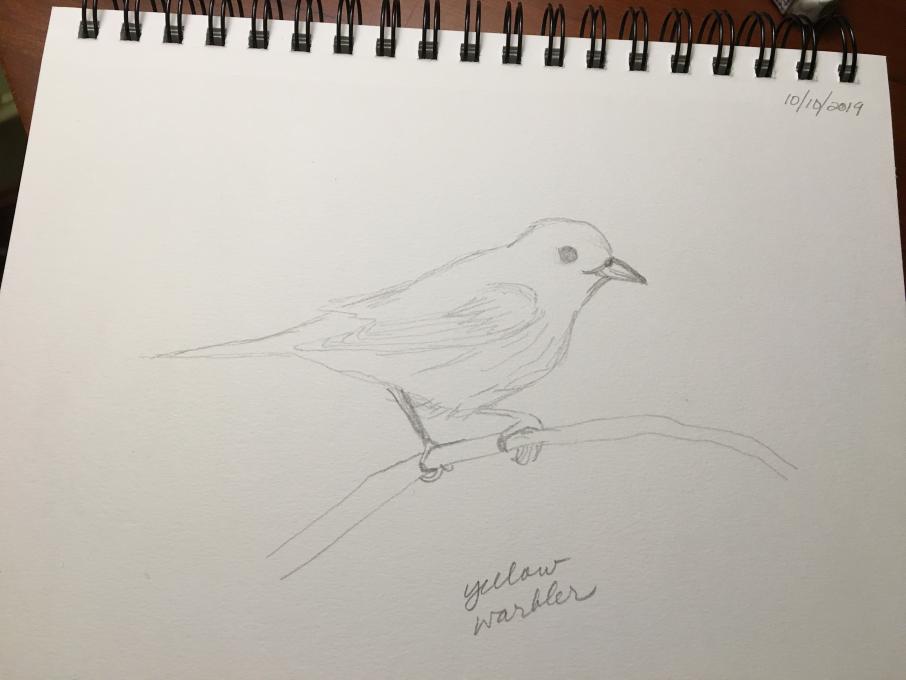 It was challenging to get the proportions correct and I struggled with drawing the feet on the branch and getting the beak right. Looking at a photo allowed me to concentrate on details that might have passed me by if this were a live subject.
It was challenging to get the proportions correct and I struggled with drawing the feet on the branch and getting the beak right. Looking at a photo allowed me to concentrate on details that might have passed me by if this were a live subject. 


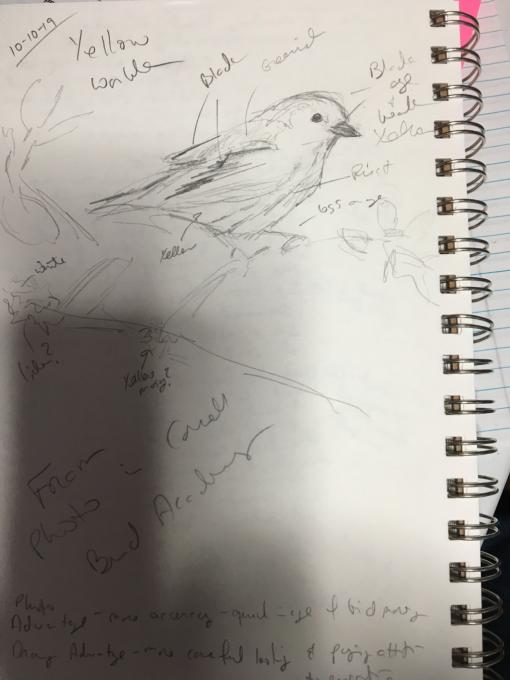 1.I enjoyed drawing the warbler from the photo. what was easy- getting general head/body/tail shape and rough in of color markings. more challenging was getting the beak shape. and also the lichens and moss? on the branch
2. drawing the scene rather than photoing it made me slow down and really look at the subtleties of the shading on the warbler's head, shape of its beak and also the lichens and moss on the branch.
1.I enjoyed drawing the warbler from the photo. what was easy- getting general head/body/tail shape and rough in of color markings. more challenging was getting the beak shape. and also the lichens and moss? on the branch
2. drawing the scene rather than photoing it made me slow down and really look at the subtleties of the shading on the warbler's head, shape of its beak and also the lichens and moss on the branch. 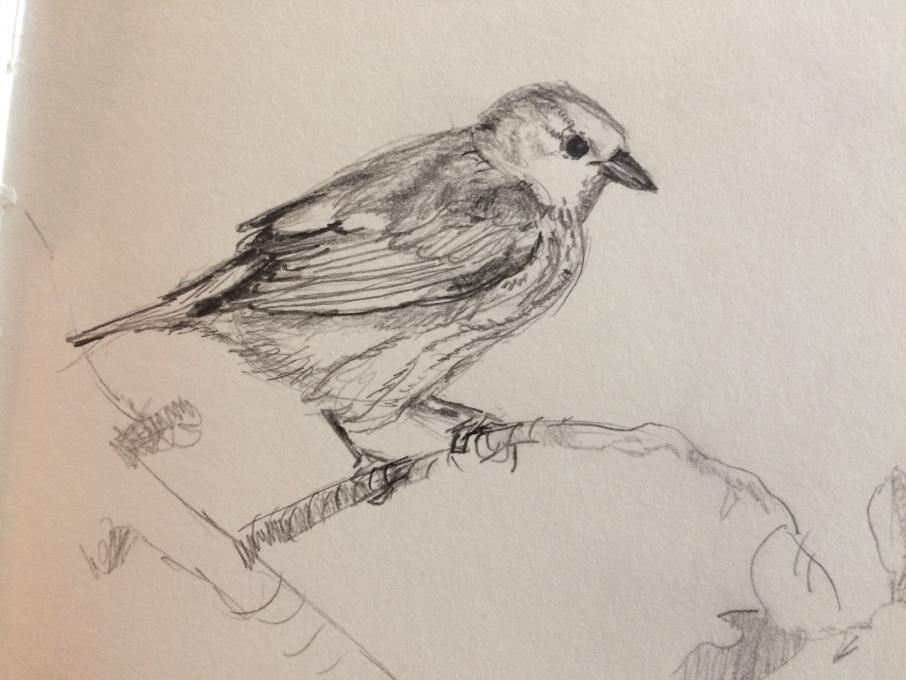
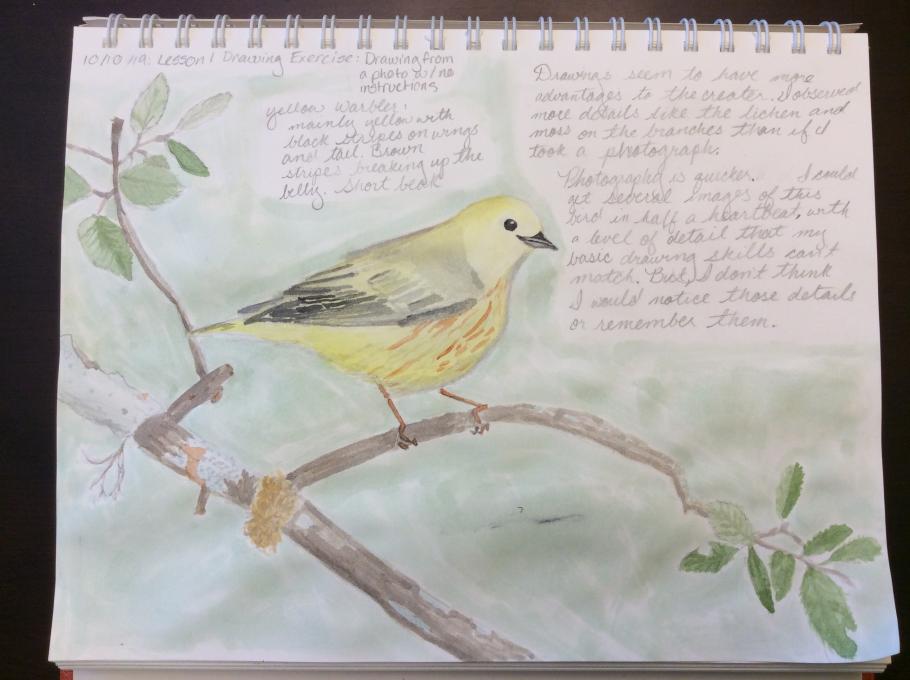
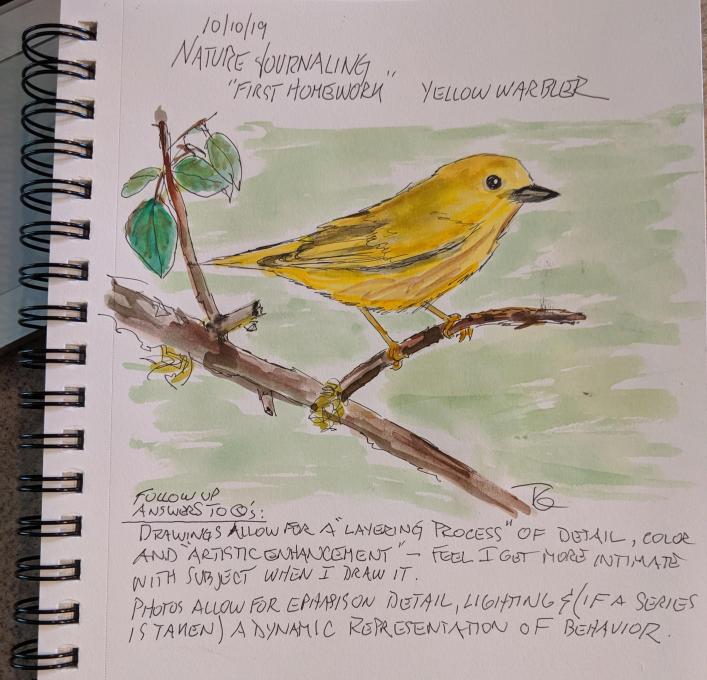 Enjoyed seeing others' contributions...we all see and render differently and then of course there's the relationship with the pencil (forgiving, correctable) & then pen (INK! oh my!). Adding color is fun, scary too, and often I go too far and things get muddy...find it's helpful to take a pic of the drawing before applying color, then I have that for my records and also could print out and try another go at colorization, including using different mediums...
oh...THOSE questions: I noticed the subtlety of the yellow coloring, the black feather tips and I really liked drawing the branch too.
Enjoyed seeing others' contributions...we all see and render differently and then of course there's the relationship with the pencil (forgiving, correctable) & then pen (INK! oh my!). Adding color is fun, scary too, and often I go too far and things get muddy...find it's helpful to take a pic of the drawing before applying color, then I have that for my records and also could print out and try another go at colorization, including using different mediums...
oh...THOSE questions: I noticed the subtlety of the yellow coloring, the black feather tips and I really liked drawing the branch too. 
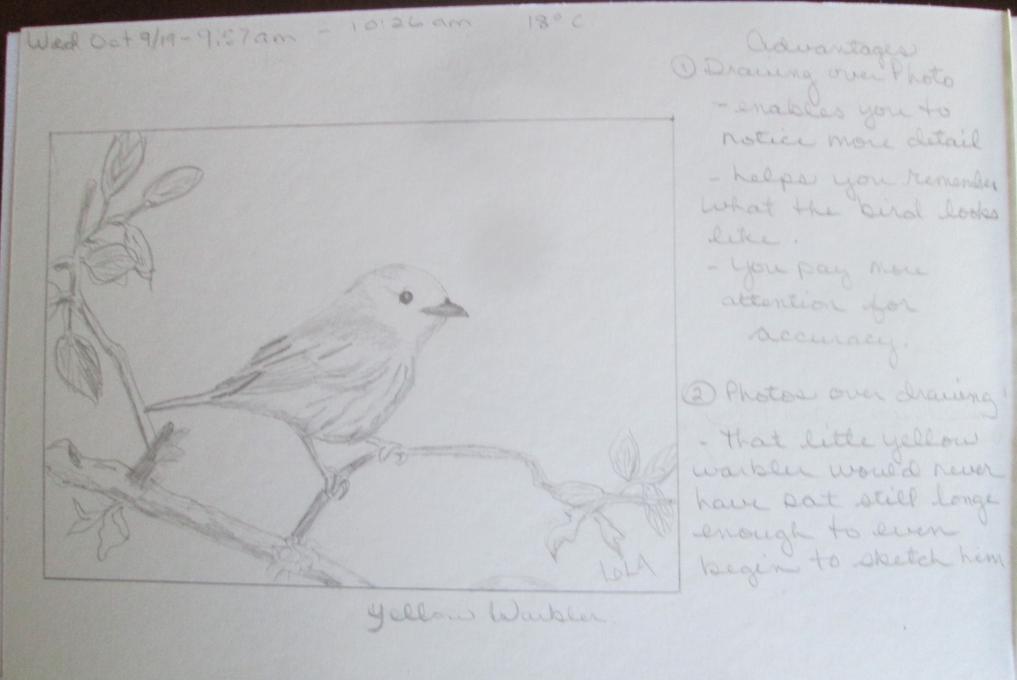
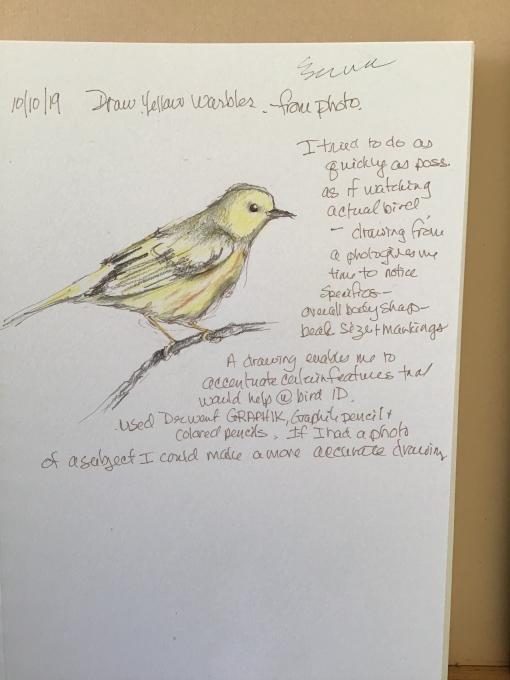

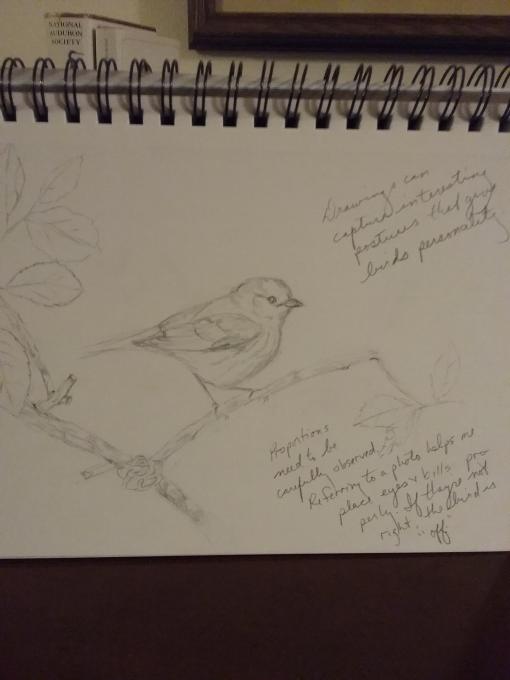

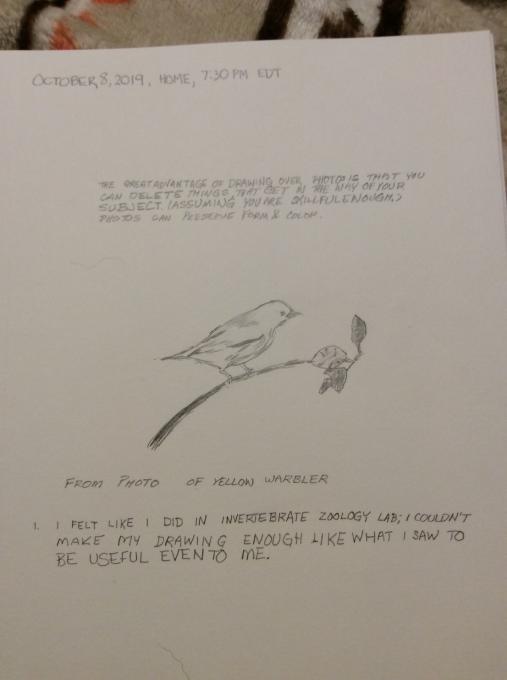

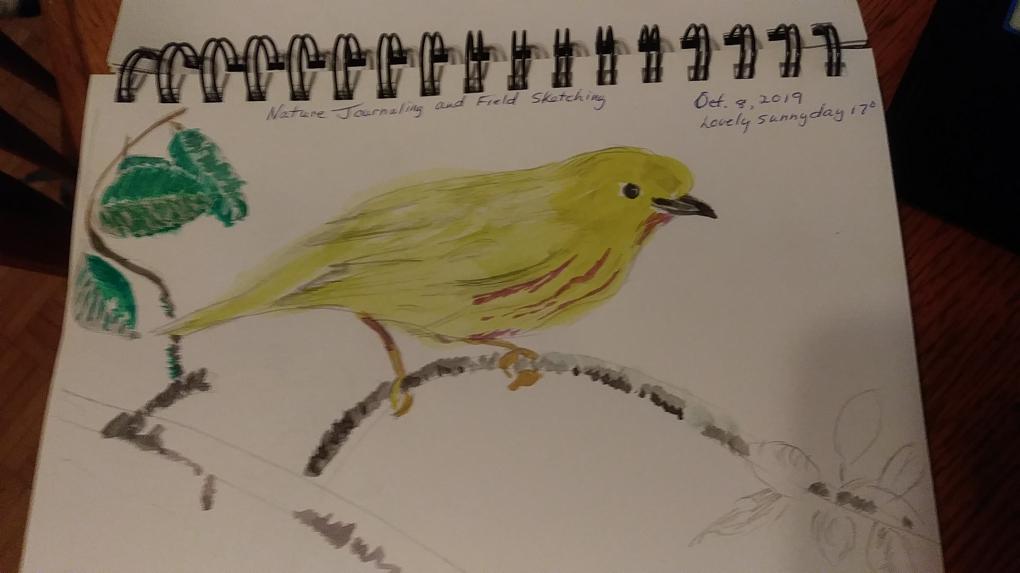 I liked drawing from a photo as it didn't fly away!!! I am really slow at these sketches! But it was a challenge to get the right colours and angles and proportions. I really enjoyed trying to get the shading right because that is what gives shape to the bird, roundness and form. Not sure I did so well at it so will be looking forward to the after sketch. Also found it a challenge to work in water colour as this is new to me. Yes, drawing the bird from a photo gives you a chance to really study all the details whereas in a momentary glimpse in the field, I would miss a lot of this.
I liked drawing from a photo as it didn't fly away!!! I am really slow at these sketches! But it was a challenge to get the right colours and angles and proportions. I really enjoyed trying to get the shading right because that is what gives shape to the bird, roundness and form. Not sure I did so well at it so will be looking forward to the after sketch. Also found it a challenge to work in water colour as this is new to me. Yes, drawing the bird from a photo gives you a chance to really study all the details whereas in a momentary glimpse in the field, I would miss a lot of this. 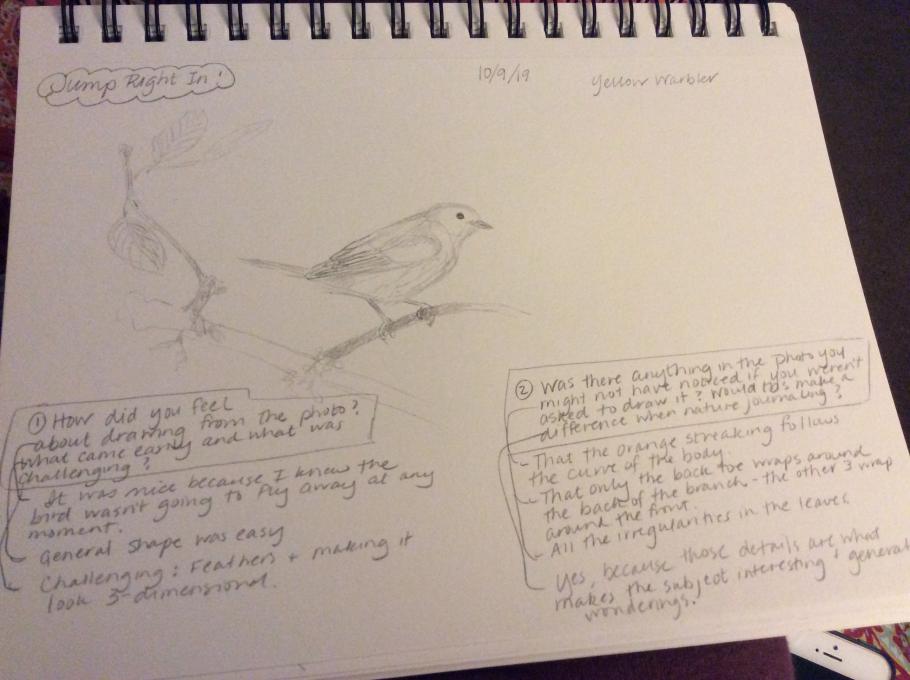
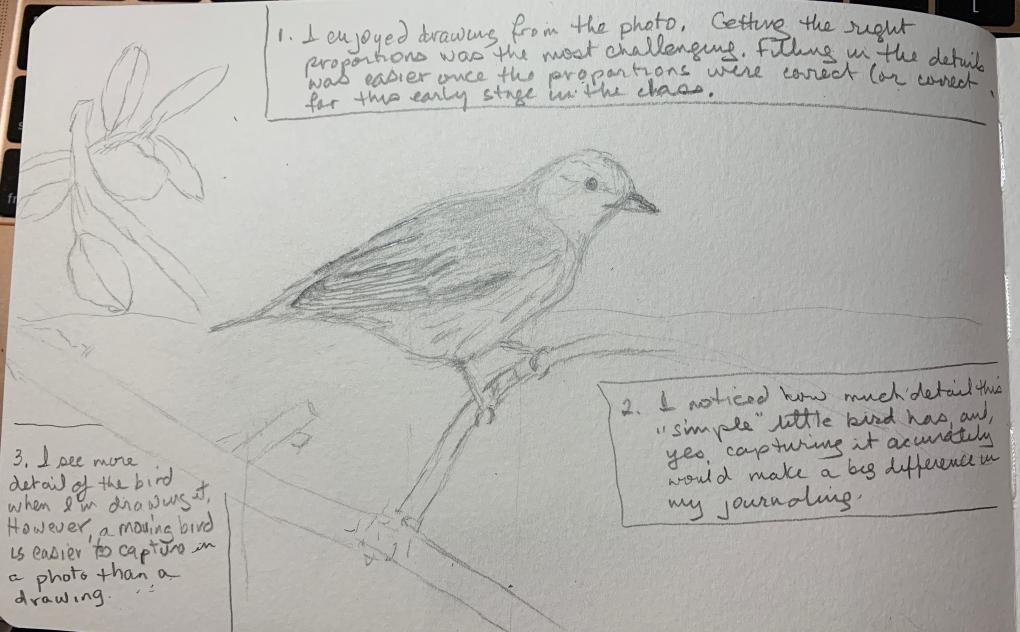
 It is great to see so many different sketching levels, that you can start even with no experience and learn from everyone else's drawings. It helps me as much to look at other's drawings as at the photo itself. It's good to start just pencil for shapes and details before worrying about the colors.
It is great to see so many different sketching levels, that you can start even with no experience and learn from everyone else's drawings. It helps me as much to look at other's drawings as at the photo itself. It's good to start just pencil for shapes and details before worrying about the colors. 